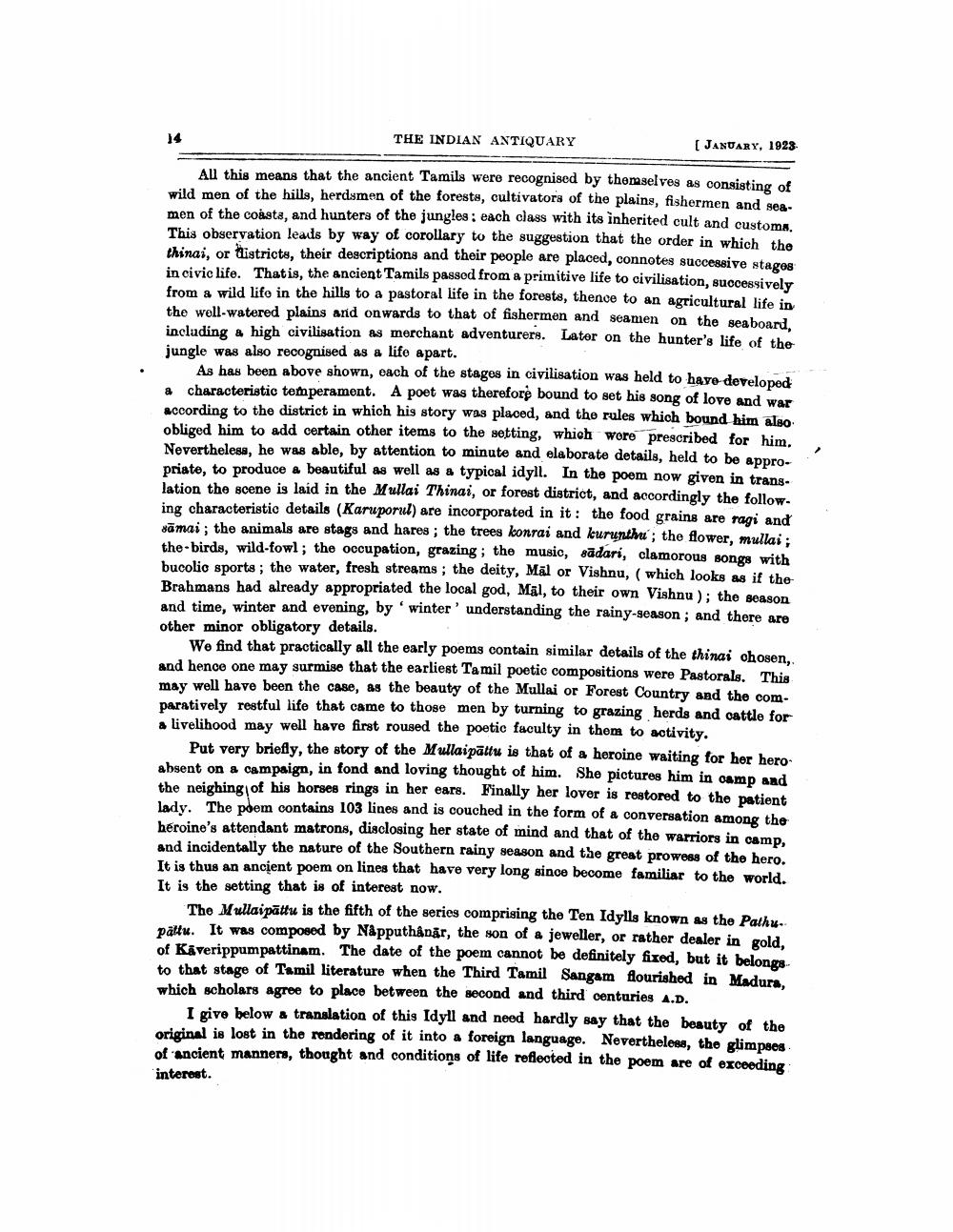________________
THE INDIAN ANTIQUARY
[ JANUARY, 1923
Al this means that the ancient Tamils were recognised by themselves as consisting of wild men of the hills, herdsmen of the forests, cultivators of the plains, fishermen and sea. men of the coasts, and hunters of the jungles : each class with its inherited cult and customs This observation leads by way of corollary to the suggestion that the order in which the thinai, or districts, their descriptions and their people are placed, connotes successive stages in civic life. That is, the ancient Tamils passed from a primitive life to civilisation, successively from a wild life in the hills to a pastoral life in the forests, thence to an agricultural life in the well-watered plains and onwards to that of fishermen and seamen on the seaboard. including & high civilisation as merchant adventurers. Later on the hunter's life of the jungle was also recognised as a lifo apart.
As has been above shown, each of the stages in civilisation was held to have developed a characteristic temperament. A poet was therefore bound to set his song of love and war according to the district in which his story was placed, and the rules which bound him algo obliged him to add certain other items to the setting, which wore prescribed for him. Nevertheless, he was able, by attention to minute and elaborate details, held to be appro. priate, to produce a beautiful as well as a typical idyll. In the poem now given in translation the scene is laid in the Mullai Thinai, or forest district, and accordingly the following characteristic details (Karuporul) are incorporated in it: the food grains are ragi and sāmai; the animals are stags and hares; the trees konrai and kurunthu; the flower, mullai; the-birds, wild-fowl; the occupation, grazing; the music, sadari, clamorous songs with bucolic sports; the water, fresh streams; the deity, Mál or Vishnu, (which looks as if the Brahmans had already appropriated the local god, Māl, to their own Vishnu); the season and time, winter and evening, by 'winter' understanding the rainy season; and there are other minor obligatory details.
We find that practically all the early poems contain similar details of the thinai chosen, and hence one may surmise that the earliest Tamil poetic compositions were Pastorals. This may well have been the case, as the beauty of the Mullai or Forest Country and the comparatively restful life that came to those men by turning to grazing herds and cattle for a livelihood may well have first roused the poetic faculty in them to activity.
Put very briefly, the story of the Mullaipāltu is that of a heroine waiting for her hero absent on a campaign, in fond and loving thought of him. She pictures him in oamp and the neighing of his horses rings in her ears. Finally her lover is restored to the patient lady. The poem contains 103 lines and is couched in the form of a conversation among the heroine's attendant matrons, disclosing her state of mind and that of the warriors in camp, and incidentally the nature of the Southern rainy season and the great prowess of the hero. It is thus an ancient poem on lines that have very long since become familiar to the world. It is the setting that is of interest now.
The Mullaipāttu is the fifth of the series comprising the Ten Idylls known as the Pathu. pattu. It was composed by Napputhânăr, the son of a jeweller, or rather dealer in gold, of Kaverippumpattinam. The date of the poem cannot be definitely fixed, but it belongs to that stage of Tamil literature when the Third Tamil Sangam flourished in Madura. which scholars agree to place between the second and third centuries A.D.
I give below a translation of this Idyll and need hardly say that the beauty of the original is lost in the rendering of it into a foreign language. Nevertheless, the glimpses of ancient manners, thought and conditions of life reflected in the poem are of exceeding interest.




